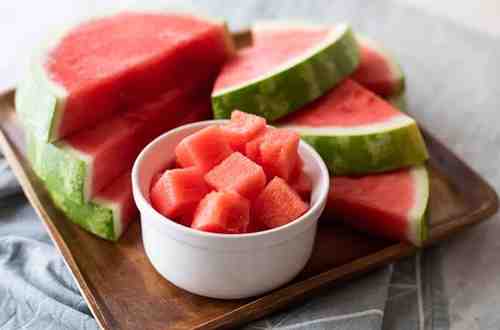Few things compare to the simple joy of biting into a perfectly ripe watermelon on a hot summer day. But the excitement can quickly turn to disappointment when you lift the lid to find your watermelon’s gone sour or feels slimy under your fingers. The secret to spotting when a watermelon’s gone off lies in knowing the tell-tale signs of spoilage, and that knowledge is essential for keeping your nosh both fresh & safe.
In this guide, we’ll explore how to recognize the early signs of spoilage and what you can do to ensure your watermelon stays fresh for as long as possible.
Contents
- 1 Getting to Know Your Watermelon
- 2 How Long Does Watermelon Really Last?
- 3 The Best Ways to Store Your Watermelon
- 4 Freezing Watermelon, the Easy Way
- 5 The Health Risks of Eating Spoiled Watermelon
- 6 Tips to Keep Your Watermelon Fresh for Longer
- 7 When It’s Just Overripe (But Still Safe to Eat)
- 8 When in Doubt, Trash the Watermelon
- 9 Conclusion
Getting to Know Your Watermelon
A fresh watermelon should be a picture of health – it should be a bright, vibrant color, with a sweet and pleasant aroma. If you cut it open, you should see a crisp, red or pink interior, depending on the variety. However, as time passes, the natural sugars in the watermelon begin to break down, causing it to become soft and mushy. And if bacteria or mold get in on the act, the thing is doomed to spoil.
To enjoy every bite, you need to spot these warning signs before you even start eating.
1. Check the Outside First: What Your Rind’s Telling You
Before you even think about cutting into that watermelon, have a good look at it – and give it a gentle touch too.
- Soft spots or dents: A watermelon that’s starting to go will have soft or wrinkled areas on the rind – it’s a sign that the fruit inside is breaking down too.
- Mold on the outside: White, green or black fuzzy patches around the stem or on the surface indicate that the watermelon’s gone bad.
- Dry or leaking stem: If the stem is dry, the watermelon is over-ripe. If it’s wet or sticky, fermentation has likely begun.
- Discoloration: If the rind’s dull or patchy, that’s another sign your watermelon’s no longer fresh.
By the way, it’s worth remembering that any cracks, cuts or bruises you see can be a breeding ground for bacteria.
2. What’s Going on Inside? Flesh, Color and Texture
Once you cut your watermelon, really study it – look at the color, texture, and smell.
- Color: Look for a bright, vibrant red or pink – if it’s dull, brownish or grey, it’s time to chuck it.
- Texture: You want it to be crisp and juicy – slimy, mushy or gritty is a sure sign it’s gone off.
- Seeds: Black or white seeds are fine, but if they’re moldy or shriveled – that’s a problem.
- Water separation: If there’s a puddle of water around the flesh, that’s a sign that the fruit’s cells have started to break down.
As these signs become more pronounced, you can be pretty sure that fermentation or bacterial spoilage has started.
3. The Smell Test – The Easiest Way to Be Sure
And finally, the most obvious way to tell if your watermelon has gone bad: the smell test.
- Sour or vinegar-like: That’s a sign fermentation started – and you don’t want that in your watermelon!
- Chemical or bitter: That could mean bacteria have got in, or that the watermelon’s over-ripe.
- No smell, but a funny taste: Sometimes you won’t know it’s gone bad just by looking or smelling – but when it tastes funny, that’s a sure sign.
So, if it smells odd – don’t even think about eating it!
4. Spotting a Bad Whole Watermelon Before You Slice It
More often than not, you can tell if a whole watermelon has gone bad without cutting it open.
- The Tap Test: When you give a fresh watermelon a tap, it should produce a deep, hollow sound. On the other hand, if it’s a dull or flat thud, it means the fruit is overripe or spoiled inside.
- The Weight Test: Pick it up and hold it in your hand – a fresh one should feel heavy for its size. If it’s light, it’s probably lost some water and started to decompose.
- The Sticky Rind Test: If the rind feels sticky to the touch or has dried juice on it, then internal spoilage has probably started.
How Long Does Watermelon Really Last?
| Storage Method | Whole Watermelon | Cut Watermelon |
| Room Temperature | 7–10 days | Not recommended |
| Refrigerator | 2–3 weeks | 3–4 days |
| Freezer (chunks only) | N/A | Up to 8 months |
Pro Tip: Once your watermelon is ripe, chuck it in the fridge. Cold temperatures slow down the decay process, keeping the item fresh for a longer period.
The Best Ways to Store Your Watermelon
A Whole Watermelon
- Keep it in a cool, dry spot away from the sunshine.
- Store it on a counter or shelf – not on the floor.
- Once you cut it, move it straight to the fridge as soon as possible.
A Cut Watermelon
- Pop the slices or cubes into airtight containers.
- If you’re using a plate, cover it tightly with plastic wrap.
- Keep it refrigerated at 40 degrees Fahrenheit or below.
- Don’t go stacking heavy items on top of the container – it can crush the fruit.
Freezing Watermelon, the Easy Way
Got a glut of watermelon and don’t know what to do with it all? Freeze it for smoothies or cool drinks later on.
- Cut it up into cubes and remove the seeds.
- Spread the pieces on a tray lined with parchment paper and pop them in the freezer for 2 hours.
- Transfer it all to an airtight or freezer-safe bag.
- Label it and chuck it in the freezer for up to 8 months.
Note: Frozen watermelon won’t stay crisp once it’s thawed, but it’s perfect for smoothies, popsicles, or slushies.
The Health Risks of Eating Spoiled Watermelon
Eating bad watermelon can make you sick. If it goes bad, it can develop various nasty bacteria, such as E. coli, Salmonella, or Listeria.
Symptoms of food poisoning can include:
- Stomach cramps
- Nausea or vomiting
- Diarrhea
- Fever and fatigue
If you experience any of these symptoms after eating watermelon, drink plenty of fluids and consult a doctor.
Tips to Keep Your Watermelon Fresh for Longer
- Wash it first: Even though you don’t eat the rind, give it a rinse to get rid of any dirt or bacteria that could spread during cutting.
- Use a clean kit: Always use a clean knife and cutting board.
- Avoid moving it around a lot: Moving watermelon in and out of the fridge is a recipe for spoilage.
- Don’t store it with other fruits: Watermelon gives off ethylene gas, which can make nearby fruits ripen (and spoil) faster.
- Eat it soon after cutting: The longer it sits, the more the sugars ferment – leading to a sour taste.
When It’s Just Overripe (But Still Safe to Eat)
Sometimes a watermelon is overripe but still safe to eat. Here’s how to tell:
- The flesh feels grainy or mealy.
- The flavor is less sweet or slightly bland.
- The texture is watery instead of juicy.
- The seeds come loose easily.
You can still use these melons for smoothies, fruit juices, or frozen treats, rather than eating them fresh.
When in Doubt, Trash the Watermelon
If you ever wonder if watermelon has gone bad, play it safe and bin it. A fresh watermelon is actually pretty cheap compared to the risk of getting a food bug – and no one wants that. Remember, when in doubt – chuck it out – “Better safe than sorry” is the motto here.
Conclusion
Knowing what to look out for in a watermelon that’s gone past its best is the key to still enjoying this summer treat safely. Always give it the once-over for stinky smells, slimy texture, and discoloration before deciding to eat it. Store it properly, chuck it in the fridge when you cut it and freeze any leftovers that won’t get eaten.
A fresh watermelon is as it should be – nice and firm, juicy and sweet, the way nature intended. Now with these easy pea tips, every slice you enjoy will be safe, a real treat, and full of flavor – and that’s the best bit.






